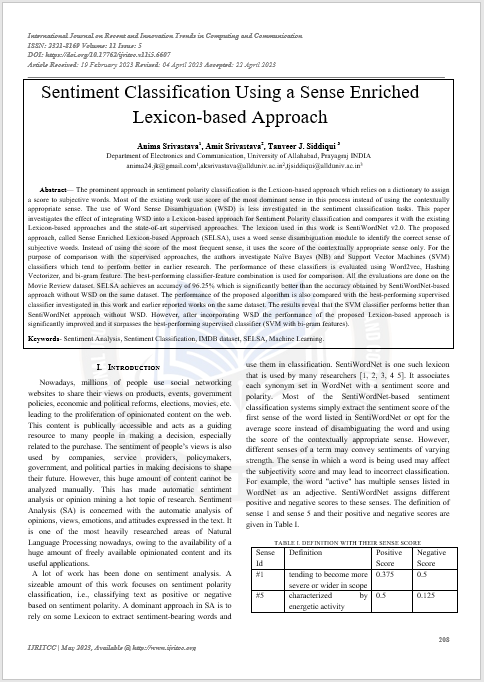Sentiment Classification Using a Sense Enriched Lexicon-based Approach
Main Article Content
Abstract
The prominent approach in sentiment polarity classification is the Lexicon-based approach which relies on a dictionary to assign a score to subjective words. Most of the existing work use score of the most dominant sense in this process instead of using the contextually appropriate sense. The use of Word Sense Disambiguation (WSD) is less investigated in the sentiment classification tasks. This paper investigates the effect of integrating WSD into a Lexicon-based approach for Sentiment Polarity classification and compares it with the existing Lexicon-based approaches and the state-of-art supervised approaches. The lexicon used in this work is SentiWordNet v2.0. The proposed approach, called Sense Enriched Lexicon-based Approach (SELSA), uses a word sense disambiguation module to identify the correct sense of subjective words. Instead of using the score of the most frequent sense, it uses the score of the contextually appropriate sense only. For the purpose of comparison with the supervised approaches, the authors investigate Naïve Bayes (NB) and Support Vector Machines (SVM) classifiers which tend to perform better in earlier research. The performance of these classifiers is evaluated using Word2vec, Hashing Vectorizer, and bi-gram feature. The best-performing classifier-feature combination is used for comparison. All the evaluations are done on the Movie Review dataset. SELSA achieves an accuracy of 96.25% which is significantly better than the accuracy obtained by SentiWordNet-based approach without WSD on the same dataset. The performance of the proposed algorithm is also compared with the best-performing supervised classifier investigated in this work and earlier reported works on the same dataset. The results reveal that the SVM classifier performs better than SentiWordNet approach without WSD. However, after incorporating WSD the performance of the proposed Lexicon-based approach is significantly improved and it surpasses the best-performing supervised classifier (SVM with bi-gram features).
Article Details
References
S. Agrawal and T. Siddiqui, “Using syntactic and contextual information for sentiment polarity analysis”, ICIS, Seoul, Korea, ACM, 978-1-60558-710-3/09/11, (2009).
S. Agrawal and T.J. Siddiqui, “Feature based star rating of reviews: A knowledge-based approach for document sentiment classification”, International Journal of Hybrid Information Technology 5 (4), 95-110, (2012).
A. Devitt, and K. Ahmad, “ Sentiment Polarity Identification in Financial News: A Cohesion-based Approach”, Proceedings of the 45th Annual Meeting of the Association of Computational Linguistics, Prague, Czech Republic, pp. 984–991, (2007).
E. W. Pamungkas and D.G.P. Putri, “Word sense disambiguation for lexicon-based sentiment analysis”, In Proceedings of the 9th International Conference on Machine Learning and Computing, 442-446, (2017).
S. Tofighy and S. M. Fakhrahmad, “A proposed scheme for sentiment analysis: Effective feature reduction based on statistical information of SentiWordNet”, Kybernetes, Vol. 47 No. 5, pp. 957-984. https://doi.org/10.1108/K-06-2017-0229, (2018).
C. Hung, and S. J. Chen, “Word sense disambiguation-based sentiment lexicons for sentiment classification”, Knowledge-Based Systems, Volume 110, Pages 224-232, https://doi.org/10.1016/j.knosys.2016.07.030, (2016).
S. Seifollahi and M. Shajari, “Word sense disambiguation application in sentiment analysis of news headlines: an applied approach to FOREX market prediction”, Journal of Intelligent System, 52, 57–83, https://doi.org/10.1007/s10844-018-0504-9, (2019).
B. Pang, L. Lee and S. Vaithyanathan, “Thumbs up? Sentiment Classification using Machine Learning Techniques”, Proceedings of the Conference on Empirical Methods in Natural Language Processing (EMNLP), Philadelphia, ACL, pp. 79-86, (2002).
N. V. Patel and H. Chhinkaniwala, “Investigating Machine Learning Techniques for User Sentiment Analysis”, International Journal of Decision Support System Technology, 11(3), (2019).
P.D. Turney, and M.L. Littman, “Measuring Praise and Criticism: Inference of Semantic Orientation from Association”, ACM Transactions on Information Systems, 21(4), pages 315–346, (2003).
V. Hatzivassiloglou and K. R. McKeown, “Predicting the Semantic Orientation of Adjectives”, Proceedings of ACL-97, 35th Annual Meeting of the Association for Computational Linguistics, Madrid, ES, pp. 174–181, (1997).
M. Taboada, J. M. Brooke, K. V. Tofiloski and M. Stede, “Lexicon-based methods for sentiment analysis”, Computational Linguistics, 37 (2), 267–307, (2011).
E. Riloff, J. Wiebe and T. Wilson, “Learning Subjective Nouns using Extraction Pattern Bootstrapping”, Proceedings of CONLL-03, 7th Conference on Natural Language Learning, Edmonton, CA, pp. 25–32, (2003).
S. M. Kim, and E. Hovy, “Determining the Sentiment of Opinions”, Proceedings of COLING-04, 20th International Conference on Computational Linguistics, Geneva, pp. 1367–1373, (2004).
B. Pang, and L. Lee, “Opinion Mining and Sentiment Analysis”, Foundations and Trends in Information Retrieval, vol. 2, pp. 1–135, (2008).
G. Tripathi and S. Naganna, “Feature selection and classification approach for sentiment analysis”, Machine Learning and Applications, An International Journal, 2(2), (2015).
N. F. F. Dasilvaa, E.R. Hruschkaa and E. R. Hruschka Jr, “Tweet sentiment analysis with classifier ensembles”, Decision Support Systems, Elsevier, 60, 170-179, (2014).
S. Sazzed and S. Jayarathna, “A Self-supervised Sentiment Analyzer for classification from unlabeled data, Machine Learning with Applications”, Volume 4, 15 June 2021, 100026, https://doi.org/10.1016/j.mlwa.2021.100026, (2021).
I. Gupta and N. Joshi, “Enhanced Twitter Sentiment Analysis Using Hybrid Approach and by Accounting Local Contextual Semantic”, Journal of Intelligent System, 29(1): 1611-1625, DeGruyter, https://doi.org/10.1515/jisys-2019-0106, (2020).
W. Medhat, A. Hassan and H. Korashy, “Sentiment analysis algorithms and applications: A survey”, Ain Shams Engineering Journal, Elsevier, 5(4), 1093-1113, (2014).
M. Birjali, M. Kasri, and A. B. Hssane, “A comprehensive survey on sentiment analysis: Approaches, challenges and trends”, Knowledge-Based Systems, Elsevier, Volume 226, (2021).
M. Wankhade, A. C. S. Rao and C. Kulkarni, “A survey on sentiment analysis methods, applications and challenges”, Artificial Intelligence Review, https://doi.org/10.1007/s10462-022-10144-1, (2022)
F. H. Khan, U. Qamar and S. Bashir, “SentiMI: Introducing point-wise mutual information with SentiWordNet to improve sentiment polarity detection”, Applied Soft Computing, pp. 140-153, 39, (2016).
S. Liu, F. Li, F. Li, X. Cheng and H. Shen, “Adaptive co-training SVM for sentiment classification on tweets”, In Proceedings of the 22nd ACM International Conference on Information & Knowledge Management, ACM, (pp. 2079-2088), (2013).

